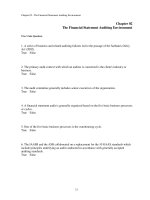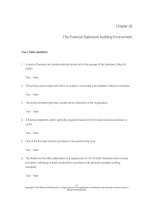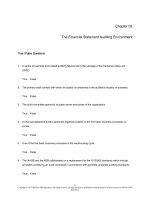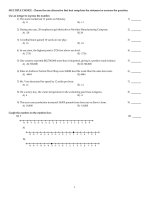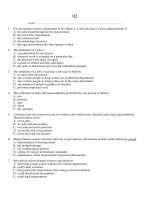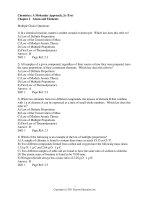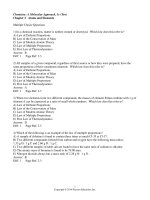College physics a strategic approach 3rd edition knight test bank
Bạn đang xem bản rút gọn của tài liệu. Xem và tải ngay bản đầy đủ của tài liệu tại đây (594.41 KB, 47 trang )
College Physics: A Strategic Approach, 3e (Knight)
Chapter 2 Motion in One Dimension
2.1 Conceptual Questions
1) Consider a deer that runs from point A to point B. The distance the deer runs can be greater
than the magnitude of its displacement, but the magnitude of the displacement can never be
greater than the distance it runs.
A) True
B) False
Answer: A
Var: 1
2) Which of the following quantities has units of a displacement? (There could be more than one
correct choice.)
A) 32 ft/s2 vertically downward
B) 40 km southwest
C) 9.8 m/s2
D) -120 m/s
E) 186,000 mi
Answer: B, E
Var: 1
3) Suppose that an object travels from one point in space to another. Make a comparison
between the magnitude of the displacement and the distance traveled by this object.
A) The displacement is either greater than or equal to the distance traveled.
B) The displacement is always equal to the distance traveled.
C) The displacement is either less than or equal to the distance traveled.
D) The displacement can be either greater than, smaller than, or equal to the distance traveled.
Answer: C
Var: 1
4) Consider a car that travels between points A and B. The car's average speed can be greater
than the magnitude of its average velocity, but the magnitude of its average velocity can never be
greater than its average speed.
A) True
B) False
Answer: A
Var: 1
1
Copyright © 2015 Pearson Education, Inc.
5) Which of the following quantities has units of a velocity? (There could be more than one
correct choice.)
A) 40 km southwest
B) -120 m/s
C) 9.8 m/s2 downward
D) 186,000 mi
E) 9.8 m/s downward
Answer: B, E
Var: 1
6) When is the average velocity of an object equal to the instantaneous velocity?
A) only when the velocity is increasing at a constant rate
B) only when the velocity is decreasing at a constant rate
C) when the velocity is constant
D) always
E) never
Answer: C
Var: 1
7) You drive 6.0 km at 50 km/h and then another 6.0 km at 90 km/h. Your average speed over
the 12 km drive will be
A) greater than 70 km/h.
B) equal to 70 km/h.
C) less than 70 km/h.
D) exactly 38 km/h.
E) It cannot be determined from the information given because we must also know directions
traveled.
Answer: C
Var: 1
8) If the velocity of an object is zero at some point, then its acceleration must also be zero at that
point.
A) True
B) False
Answer: B
Var: 1
9) Which of the following situations is impossible?
A) An object has velocity directed east and acceleration directed west.
B) An object has velocity directed east and acceleration directed east.
C) An object has zero velocity but non-zero acceleration.
D) An object has constant non-zero acceleration and changing velocity.
E) An object has constant non-zero velocity and changing acceleration.
Answer: E
Var: 1
2
Copyright © 2015 Pearson Education, Inc.
10) If the acceleration of an object is zero, then that object cannot be moving.
A) True
B) False
Answer: B
Var: 1
11) If the velocity of an object is zero, then that object cannot be accelerating.
A) True
B) False
Answer: B
Var: 1
12) Suppose that a car traveling to the west begins to slow down as it approaches a traffic light.
Which of the following statements about its acceleration is correct?
A) The acceleration is toward the east.
B) Since the car is slowing down, its acceleration must be negative.
C) The acceleration is zero.
D) The acceleration is toward the west.
Answer: A
Var: 1
13) An auto manufacturer advertises that their car can go "from zero to sixty in eight seconds."
This is a description of what characteristic of the car's motion?
A) average speed
B) instantaneous speed
C) average acceleration
D) instantaneous acceleration
E) displacement
Answer: C
Var: 1
14) An object moving in the +x direction experiences an acceleration of +2.0 m/s2. This means
the object
A) travels 2.0 m in every second.
B) is traveling at 2.0 m/s.
C) is decreasing its velocity by 2.0 m/s every second.
D) is increasing its velocity by 2.0 m/s every second.
Answer: D
Var: 1
3
Copyright © 2015 Pearson Education, Inc.
15) Suppose that a car traveling to the east (+x direction) begins to slow down as it approaches a
traffic light. Which statement concerning its acceleration must be correct?
A) Its acceleration is in the +x direction.
B) Its acceleration is in the -x direction.
C) Its acceleration is zero.
D) Its acceleration is decreasing in magnitude as the car slows down.
Answer: B
Var: 1
16) Suppose that a car traveling to the west (-x direction) begins to slow down as it approaches a
traffic light. Which statement concerning its acceleration must be correct?
A) Its acceleration is positive.
B) Its acceleration is negative.
C) Its acceleration is zero.
D) Its acceleration is decreasing in magnitude as the car slows down.
Answer: A
Var: 1
17) Suppose that an object is moving with a constant velocity. Which statement concerning its
acceleration must be correct?
A) The acceleration is constantly increasing.
B) The acceleration is constantly decreasing.
C) The acceleration is a constant non-zero value.
D) The acceleration is equal to zero.
Answer: D
Var: 1
18) If the velocity of an object is zero at one instant, what is true about the acceleration of that
object? (There could be more than one correct choice.)
A) The acceleration could be positive.
B) The acceleration could be negative.
C) The acceleration could be zero.
D) The acceleration must be zero.
Answer: A, B, C
Var: 1
19) Under what condition is average velocity equal to the average of the object's initial and final
velocity?
A) This can only occur if there is no acceleration.
B) The acceleration is constant.
C) This can occur only when the velocity is zero.
D) The acceleration must be constantly increasing.
E) The acceleration must be constantly decreasing.
Answer: B
Var: 1
4
Copyright © 2015 Pearson Education, Inc.
20) A racing car accelerates uniformly from rest along a straight track. This track has markers
spaced at equal distances along it from the start, as shown in the figure. The car reaches a speed
of 140 km/h as it passes marker 2.
Where on the track was the car when it was traveling at half this speed, that is at 70 km/h?
A) Before marker 1
B) At marker 1
C) Between marker 1 and marker 2
Answer: A
Var: 1
21) When a ball is thrown straight up with no air resistance, the acceleration at its highest point
A) is upward
B) is downward
C) is zero
D) reverses from upward to downward
E) reverses from downward to upward
Answer: B
Var: 1
22) A rock from a volcanic eruption is launched straight up into the air with no appreciable air
resistance. Which one of the following statements about this rock while it is in the air is correct?
A) On the way up, its acceleration is downward and its velocity is upward, and at the highest
point both its velocity and acceleration are zero.
B) On the way down, both its velocity and acceleration are downward, and at the highest point
both its velocity and acceleration are zero.
C) Throughout the motion, the acceleration is downward, and the velocity is always in the same
direction as the acceleration.
D) The acceleration is downward at all points in the motion.
E) The acceleration is downward at all points in the motion except that is zero at the highest
point.
Answer: D
Var: 1
23) Suppose a ball is thrown straight up and experiences no appreciable air resistance. What is
its acceleration just before it reaches its highest point?
A) zero
B) slightly less than g
C) exactly g
D) slightly greater than g
Answer: C
Var: 1
5
Copyright © 2015 Pearson Education, Inc.
24) A ball is thrown straight up, reaches a maximum height, then falls to its initial height. Which
of the following statements about the direction of the velocity and acceleration of the ball as it is
going up is correct?
A) Both its velocity and its acceleration point upward.
B) Its velocity points upward and its acceleration points downward.
C) Its velocity points downward and its acceleration points upward.
D) Both its velocity and its acceleration points downward.
Answer: B
Var: 1
25) A ball is thrown downward in the absence of air resistance. After it has been released, which
statement(s) concerning its acceleration is correct? (There could be more than one correct
choice.)
A) Its acceleration is constantly increasing.
B) Its acceleration is constant.
C) Its acceleration is constantly decreasing.
D) Its acceleration is zero.
E) Its acceleration is greater than g.
Answer: B
Var: 1
26) A 10-kg rock and a 20-kg rock are thrown upward with the same initial speed v0 and
experience no significant air resistance. If the 10-kg rock reaches a maximum height h, what
maximum height will the 20-kg ball reach?
A) h/4
B) h/2
C) h
D) 2h
E) 4h
Answer: C
Var: 1
27) A 10-kg rock and 20-kg rock are dropped from the same height and experience no significant
air resistance. If it takes the 20-kg rock a time T to reach the ground, what time will it take the
10-kg rock to reach the ground?
A) 4T
B) 2T
C) T
D) T/2
E) T/4
Answer: C
Var: 1
6
Copyright © 2015 Pearson Education, Inc.
28) A 10-kg rock and a 20-kg rock are dropped at the same time and experience no significant air
resistance. If the 10-kg rock falls with acceleration a, what is the acceleration of the 20-kg rock?
A) 4a
B) 2a
C) a
D) a/2
E) a/4
Answer: C
Var: 1
29) Two objects are dropped from a bridge, an interval of 1.0 s apart. Air resistance is negligible.
During the time that both objects continue to fall, their separation
A) increases.
B) decreases.
C) stays constant.
D) increases at first, but then stays constant.
E) decreases at first, but then stays constant.
Answer: A
Var: 1
30) From the edge of a roof top you toss a green ball upwards with initial speed v0 and a blue
ball downwards with the same initial speed. Air resistance is negligible. When they reach the
ground below
A) the green ball will be moving faster than the blue ball.
B) the blue ball will be moving faster than the green ball.
C) the two balls will have the same speed.
Answer: C
Var: 1
31) Ball A is dropped from the top of a building. One second later, ball B is dropped from the
same building. Neglect air resistance. As time progresses, the difference in their speeds
A) increases.
B) remains constant.
C) decreases.
D) cannot be determined from the information given.
Answer: B
Var: 1
32) Two objects are thrown from the top of a tall building. One is thrown up, and the other is
thrown down, both with the same initial speed. What are their speeds when they hit the street?
Neglect air resistance.
A) The one thrown up is traveling faster.
B) The one thrown down is traveling faster.
C) They are traveling at the same speed.
D) It is impossible to tell because the height of the building is not given.
Answer: C
Var: 1
7
Copyright © 2015 Pearson Education, Inc.
33) Brick A is dropped from the top of a building. Brick B is thrown straight down from the
same building, and neither one experiences appreciable air resistance. Which statement about
their accelerations is correct?
A) The acceleration of A is greater than the acceleration of B.
B) The acceleration of B is greater than the acceleration of A.
C) The two bricks have exactly the same acceleration.
D) Neither brick has any acceleration once it is released.
Answer: C
Var: 1
34) An object is moving with constant non-zero velocity in the +x direction. The position versus
time graph of this object is
A) a horizontal straight line.
B) a vertical straight line.
C) a straight line making an angle with the time axis.
D) a parabolic curve.
Answer: C
Var: 1
35) An object is moving with constant non-zero acceleration in the +x direction. The position
versus time graph of this object is
A) a horizontal straight line.
B) a vertical straight line.
C) a straight line making an angle with the time axis.
D) a parabolic curve.
Answer: D
Var: 1
36) An object is moving with constant non-zero velocity in the +x direction. The velocity versus
time graph of this object is
A) a horizontal straight line.
B) a vertical straight line.
C) a straight line making an angle with the time axis.
D) a parabolic curve.
Answer: A
Var: 1
37) An object is moving with constant non-zero acceleration in the +x direction. The velocity
versus time graph of this object is
A) a horizontal straight line.
B) a vertical straight line.
C) a straight line making an angle with the time axis.
D) a parabolic curve.
Answer: C
Var: 1
8
Copyright © 2015 Pearson Education, Inc.
38) The slope of a position versus time graph gives
A) the distance traveled.
B) velocity.
C) acceleration.
D) displacement.
Answer: B
Var: 1
39) The slope of a velocity versus time graph gives
A) the distance traveled.
B) velocity.
C) acceleration.
D) displacement.
Answer: C
Var: 1
40) If the position versus time graph of an object is a horizontal line, the object is
A) moving with constant non-zero speed.
B) moving with constant non-zero acceleration.
C) at rest.
D) moving with increasing speed.
Answer: C
Var: 1
41) If the velocity versus time graph of an object is a horizontal line, the object is
A) moving with zero acceleration.
B) moving with constant non-zero acceleration.
C) at rest.
D) moving with increasing speed.
Answer: A
Var: 1
42) If the velocity versus time graph of an object is a straight line making an angle of +30°
(counter clockwise) with the time axis, the object is
A) moving with constant non-zero speed.
B) moving with constant non-zero acceleration.
C) at rest.
D) moving with increasing acceleration.
Answer: B
Var: 1
9
Copyright © 2015 Pearson Education, Inc.
43) The motions of a car and a truck along a straight road are represented by the velocity-time
graphs in the figure. The two vehicles are initially alongside each other at time t = 0.
At time T, what is true of the distances traveled by the vehicles since time t = 0?
A) They will have traveled the same distance.
B) The truck will not have moved.
C) The car will have travelled further than the truck.
D) The truck will have travelled further than the car.
Answer: D
Var: 1
10
Copyright © 2015 Pearson Education, Inc.
44) Which of the following graphs represent an object at rest? (There could be more than one
correct choice.)
A) graph a
B) graph b
C) graph c
D) graph d
E) graph e
Answer: A
Var: 1
11
Copyright © 2015 Pearson Education, Inc.
45) Which of the following graphs represent an object having zero acceleration?
A) only graph a
B) only graph b
C) graphs a and b
D) graphs b and c
E) graphs c and d
Answer: C
Var: 1
46) The figure shows a graph of the position x of two cars, C and D, as a function of time t.
According to this graph, which statements about these cars must be true? (There could be more
than one correct choice.)
A) The magnitude of the acceleration of car C is greater than the magnitude of the acceleration
of car D.
B) The magnitude of the acceleration of car C is less than the magnitude of the acceleration of
car D.
C) At time t = 10 s, both cars have the same velocity.
D) Both cars have the same acceleration.
E) The cars meet at time t = 10 s.
Answer: D, E
Var: 1
12
Copyright © 2015 Pearson Education, Inc.
47) The graph in the figure shows the position of an object as a function of time. The letters H-L
represent particular moments of time.
(a) At which moment in time is the speed of the object the greatest?
(b) At which moment in time is the speed of the object equal to zero?
Answer: (a) J (b) I
Var: 1
13
Copyright © 2015 Pearson Education, Inc.
48) A child standing on a bridge throws a rock straight down. The rock leaves the child's hand at
time t = 0 s. If we take upward as the positive direction, which of the graphs shown below best
represents the velocity of the stone as a function of time?
Answer: C
Var: 1
14
Copyright © 2015 Pearson Education, Inc.
49) A child standing on a bridge throws a rock straight down. The rock leaves the child's hand at
time t = 0 s. If we take upward as the positive direction, which of the graphs shown below best
represents the acceleration of the stone as a function of time?
Answer: B
Var: 1
50) The motion of a particle is described in the velocity vs. time graph shown in the figure.
Over the nine-second interval shown, we can say that the speed of the particle
A) only increases.
B) only decreases.
C) increases and then decreases.
D) decreases and then increases.
E) remains constant.
Answer: D
Var: 1
15
Copyright © 2015 Pearson Education, Inc.
51) The graph in the figure shows the position of a particle as it travels along the x-axis.
At what value of t is the speed of the particle equal to 0 m/s?
A) 0 s
B) 1 s
C) 2 s
D) 3 s
E) 4 s
Answer: D
Var: 1
52) The area under a curve in a velocity versus time graph gives
A) acceleration.
B) velocity.
C) displacement.
D) position.
Answer: C
Var: 1
16
Copyright © 2015 Pearson Education, Inc.
2.2 Problems
1) If, in the figure, you start from the Bakery, travel to the Cafe, and then to the Art Gallery
(a) what distance you have traveled?
(b) what is your displacement?
Answer: (a) 10.5 km
Var: 1
(b) 2.50 km south
2) An object moves 15.0 m north and then 11.0 m south. Find both the distance it has traveled
and the magnitude of its displacement.
A) 4.0 m, 26.0 m
B) 26.0 m, 4.0 m
C) 26.0 m, 26.0 m
D) 4.0 m, 4.0 m
Answer: B
Var: 1
3) What must be your average speed in order to travel 350 km in 5.15 h?
A) 66.0 km/h
B) 67.0 km/h
C) 68.0 km/h
D) 69.0 km/h
Answer: C
Var: 1
4) A runner ran the marathon (approximately 42.0 km) in 2 hours and 57 min. What was the
average speed of the runner in m/s?
A) 14,200 m/s
B) 124 m/s
C) 3.95 m/s
D) 14.2 m/s
Answer: C
Var: 1
5) A light-year is the distance that light travels in one year. The speed of light is 3.00 × 108 m/s.
How many miles are there in one light-year? (1 mi = 1609 m, 1 y = 365 d)
A) 9.46 × 1012 mi
B) 9.46 × 1015 mi
C) 5.88 × 1012 mi
D) 5.88 × 1015 mi
Answer: C
Var: 1
17
Copyright © 2015 Pearson Education, Inc.
6) If you are driving 72 km/h along a straight road and you look to the side for 4.0 s, how far do
you travel during this inattentive period?
A) 18 m
B) 20 m
C) 40 m
D) 80 m
Answer: D
Var: 4
7) If you run a complete loop around an outdoor track of length 400 m in 100 s, find your
(a) average velocity and (b) average speed.
Answer: (a) 0 m/s (b) 4 m/s
Var: 1
8) A polar bear starts at the North Pole. It travels 1.0 km south, then 1.0 km east, and then 1.0
km north to return to its starting point. This trip takes 45 min. What was the bear's average
speed?
A) 0.00 km/h
B) 0.067 km/h
C) 4.0 km/h
D) 5.3 km/h
Answer: C
Var: 1
9) A polar bear starts at the North Pole. It travels 1.0 km south, then 1.0 km east, and then 1.0
km north to return to its starting point. This trip takes 45 min. What was the bear's average
velocity?
A) 0.00 km/h
B) 0.067 km/h
C) 4.0 km/h
D) 5.3 km/h
Answer: A
Var: 1
10) You are driving home on a weekend from school at 55 mi/h for 110 miles. It then starts to
snow and you slow to 35 mi/h. You arrive home after driving 4 hours and 15 minutes. How far
is your hometown from school?
A) 180 mi
B) 190 mi
C) 200 mi
D) 210 mi
Answer: B
Var: 1
18
Copyright © 2015 Pearson Education, Inc.
11) A motorist travels 160 km at 80 km/h and 160 km at 100 km/h. What is the average speed of
the motorist for this trip?
A) 84 km/h
B) 89 km/h
C) 90 km/h
D) 91 km/h
Answer: B
Var: 1
12) A motorist travels for 3.0 h at 80 km/h and 2.0 h at 100 km/h. What is her average speed for
the trip?
A) 85 km/h
B) 88 km/h
C) 90 km/h
D) 92 km/h
Answer: B
Var: 1
13) An airplane travels at 300 mi/h south for 2.00 h and then at 250 mi/h north for 750 miles.
What is the average speed for the trip?
A) 260 mi/h
B) 270 mi/h
C) 275 mi/h
D) 280 mi/h
Answer: B
Var: 1
14) A race car circles 10 times around a circular 8.0-km track in 20 min. Using SI units
(a) what is its average speed for the ten laps?
(b) what is its average velocity for the ten laps?
Answer: (a) 67 m/s (b) 0 m/s
Var: 1
15) A bat, flying toward the east at 2.0 m/s, emits a shriek that is reflected back to it from a wall
that is 20.0 m in front of the bat at the instant the shriek is emitted. Sound travels at 340 m/s in
the air. How many milliseconds after emitting the shriek does the bat hear the reflected echo
from the wall?
Answer: 117 ms
Var: 1
19
Copyright © 2015 Pearson Education, Inc.
16) If, in the figure, you start from the Bakery, travel to the Cafe, and then to the Art Gallery in
2.00 hours, what is your
(a) average speed?
(b) average velocity?
Answer: (a) 5.25 km/h
Var: 1
(b) 1.25 km/h south
17) A runner runs around a track consisting of two parallel lines 96 m long connected at the ends
by two semicircles with a radius of 49 m. She completes one lap in 100 seconds. What is her
average velocity?
A) 2.5 m/s
B) 5.0 m/s
C) 10 m/s
D) 0 m/s
E) 1.3 m/s
Answer: D
Var: 1
18) A runner runs around a track consisting of two parallel lines 96 m long connected at the ends
by two semicircles with a radius of 49 m. She completes one lap in 100 seconds. What is her
average speed?
A) 2.5 m/s
B) 5.0 m/s
C) 10 m/s
D) 0 m/s
E) 1.3 m/s
Answer: B
Var: 1
19) You leave on a
trip in order to attend a meeting that will start
after you begin
your trip. Along the way you plan to stop for dinner. If the fastest you can safely drive is 65
mi/h, what is the longest time you can spend over dinner and still arrive just in time for the
meeting?
A) 2.4 h
B) 2.6 h
C) 1.9 h
D) You can't stop at all.
Answer: A
Var: 50+
20
Copyright © 2015 Pearson Education, Inc.
20) A motorist makes a trip of 180 miles. For the first 90 miles she drives at a constant speed of
30 mph. At what constant speed must she drive the remaining distance if her average speed for
the total trip is to be 40 mph?
A) 45 mph
B) 50 mph
C) 52.5 mph
D) 55 mph
E) 60 mph
Answer: E
Var: 1
21) Human reaction times are worsened by alcohol. How much further (in feet) would a drunk
driver's car travel before he hits the brakes than a sober driver's car? Assume that both are
initially traveling at 50.0 mi/h and their cars have the same acceleration while slowing down, and
that the sober driver takes 0.33 s to hit the brakes in a crisis, while the drunk driver takes 1.0 s to
do so. (5280 ft = 1 mi)
Answer: 49 ft
Var: 1
22) Arthur and Betty start walking toward each other when they are 100 m apart. Arthur has a
speed of 3.0 m/s and Betty has a speed of 2.0 m/s. How long does it take for them to meet?
Answer: 20 seconds
Var: 1
23) The position x(t) of a particle as a function of time t is given by the equation x(t) = (3.5 m/s)t
- (5.0 m/s2)t2. What is the average velocity of the particle between t = 0.30 s and t = 0.40 s?
Answer: 0.00 m/s
Var: 1
24) A water rocket can reach a speed of 75 m/s in 0.050 seconds from launch. What is its
average acceleration?
Answer: 1500 m/s2
Var: 1
25) An airplane increases its speed at the average rate of 15 m/s2. How much time does it take
to increase its speed from 100 m/s to 160 m/s?
A) 17 s
B) 0.058 s
C) 4.0 s
D) 0.25 s
Answer: C
Var: 1
21
Copyright © 2015 Pearson Education, Inc.
26) The captain orders his starship to accelerate from rest at a rate of "1 g" (1 g = 9.8 m/s2).
How many days does it take the starship to reach 10% the speed of light? (Light travels at 3.0 ×
108 m/s.)
Answer: 35 days
Var: 1
27) A car is traveling north at
After 12 s its velocity is
Find the magnitude and direction of the car's average acceleration.
A) 0.30 m/s2, south
B) 2.7 m/s2, south
C) 0.30 m/s2, north
D) 2.7 m/s2, north
Answer: A
Var: 50+
in the same direction.
28) A racquetball strikes a wall with a speed of 30 m/s and rebounds in the opposite direction
with a speed of 26 m/s. The collision takes 20 ms. What is the average acceleration of the ball
during the collision with the wall?
A) 0 m/s2
B) 200 m/s2
C) 2800 m/s2
D) 1500 m/s2
E) 1300 m/s2
Answer: C
Var: 1
29) The velocity v(t) of a particle as a function of time is given by v(t) = (2.3 m/s) + (4.1 m/s2)t (6.2 m/s3)t2. What is the average acceleration of the particle between t = 1.0 s and t = 2.0 s?
A) -13 m/s2
B) -15 m/s2
C) 13 m/s2
D) 15 m/s2
E) 0 m/s2
Answer: B
Var: 1
30) If a car accelerates at a uniform 4.0 m/s2, how long will it take to reach a speed of 80 km/hr,
starting from rest?
Answer: 5.6 s
Var: 1
22
Copyright © 2015 Pearson Education, Inc.
31) A car that is initially moving at 7.50 m/s begins to accelerate forward uniformly at 0.550
m/s2.
(a) How long after beginning to accelerate does it take the car to move 3.50 km?
(b) How fast is the car moving just as it has traveled 3.50 km?
Answer: (a) 1.00 × 102 s (b) 62.5 m/s
Var: 1
32) An auto accelerates forward from 7.0 m/s at a uniform 0.71 m/s2. It travels a distance of
1.033 km while accelerating.
(a) How fast is the auto moving just as it is traveled the 1.033 km?
(b) How many seconds did it take to travel the 1.033 km?
Answer: (a) 39 m/s (b) 45 s
Var: 1
33) In a ballistics test, a bullet moving horizontally with a speed of 500 m/s strikes a sandbag and
penetrates a distance of 10.0 cm.
(a) What is the magnitude of the average acceleration of the bullet in the sandbag?
(b) How many milliseconds does it take the bullet to come to rest in the sandbag?
Answer: (a) 1.25 × 106 m/s2 (b) 0.400 ms
Var: 1
34) A certain test car can go from rest to 32.0 m/s in 3.88 s. The same car can come to a full stop
from that speed in 4.14 s. What is the ratio of the magnitude of the starting acceleration to the
stopping acceleration?
A) 0.937
B) 1.07
C) 0.878
D) 1.14
Answer: B
Var: 1
35) A car initially traveling at 60 km/h accelerates at a constant rate of 2.0 m/s2. How much
time is required for the car to reach a speed of 90 km/h?
A) 15 s
B) 30 s
C) 45 s
D) 4.2 s
Answer: D
Var: 1
23
Copyright © 2015 Pearson Education, Inc.
36) A cart starts from rest and accelerates uniformly at 4.0 m/s2 for 5.0 s. It next maintains the
velocity it has reached for 10 s. Then it slows down at a steady rate of 2.0 m/s2 for 4.0 s. What
is the final speed of the car?
A) 20 m/s
B) 16 m/s
C) 12 m/s
D) 10 m/s
Answer: C
Var: 1
37) A car travels at 15 m/s for 10 s. It then speeds up with a constant acceleration of 2.0 m/s2 for
15 s. At the end of this time, what is its velocity?
A) 15 m/s
B) 30 m/s
C) 45 m/s
D) 375 m/s
Answer: C
Var: 1
38) A cart with an initial velocity of 5.0 m/s to the right experiences a constant acceleration of
2.0 m/s2 to the right. What is the cart's displacement during the first 6.0 s of this motion?
A) 10 m
B) 55 m
C) 66 m
D) 80 m
Answer: C
Var: 1
39) A jet plane is launched from a catapult on an aircraft carrier. In 2.0 s it reaches a speed of 42
m/s at the end of the catapult. Assuming the acceleration is constant, how far did it travel during
those 2.0 s?
A) 16 m
B) 24 m
C) 42 m
D) 84 m
Answer: C
Var: 1
24
Copyright © 2015 Pearson Education, Inc.
40) A car starting from rest accelerates at a constant 2.0 m/s2 for 10 s. It then travels with
constant speed it has achieved for another 10 s. Then it finally slows to a stop with constant
acceleration of magnitude 2.0 m/s2. How far does it travel after starting?
A) 200 m
B) 300 m
C) 400 m
D) 500 m
Answer: C
Var: 1
41) A car increases its forward velocity uniformly from 40 m/s to 80 m/s while traveling a
distance of 200 m. What is its acceleration during this time?
A) 8.0 m/s2
B) 9.6 m/s2
C) 12 m/s2
D) 24 m/s2
Answer: C
Var: 1
42) An object starts from rest and undergoes uniform acceleration. During the first second it
travels 5.0 m. How far will it travel during the third second?
A) 5.0 m
B) 15 m
C) 25 m
D) 45 m
Answer: C
Var: 2
43) An object is moving in a straight line with constant acceleration. Initially it is traveling at 16
m/s. Three seconds later it is traveling at 10 m/s. How far does it move during this time?
A) 30 m
B) 39 m
C) 48 m
D) 57 m
Answer: B
Var: 4
44) A car starts from rest and accelerates uniformly at 3.0 m/s2 toward the north. A second car
starts from rest 6.0 s later at the same point and accelerates uniformly at 5.0 m/s2 toward the
north. How long after the second car starts does it overtake the first car?
A) 12 s
B) 19 s
C) 21 s
D) 24 s
Answer: C
Var: 1
25
Copyright © 2015 Pearson Education, Inc.
